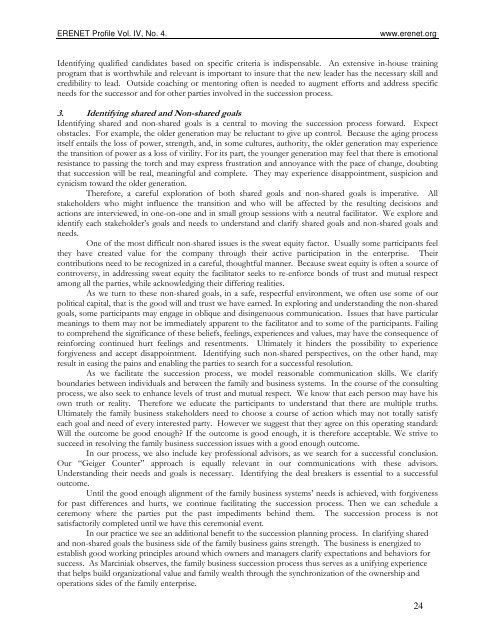Issue 16
Issue 16
Issue 16
You also want an ePaper? Increase the reach of your titles
YUMPU automatically turns print PDFs into web optimized ePapers that Google loves.
ERENET Profile Vol. IV, No. 4.<br />
www.erenet.org<br />
Identifying qualified candidates based on specific criteria is indispensable. An extensive in-house training<br />
program that is worthwhile and relevant is important to insure that the new leader has the necessary skill and<br />
credibility to lead. Outside coaching or mentoring often is needed to augment efforts and address specific<br />
needs for the successor and for other parties involved in the succession process.<br />
3. Identifying shared and Non-shared goals<br />
Identifying shared and non-shared goals is a central to moving the succession process forward. Expect<br />
obstacles. For example, the older generation may be reluctant to give up control. Because the aging process<br />
itself entails the loss of power, strength, and, in some cultures, authority, the older generation may experience<br />
the transition of power as a loss of virility. For its part, the younger generation may feel that there is emotional<br />
resistance to passing the torch and may express frustration and annoyance with the pace of change, doubting<br />
that succession will be real, meaningful and complete. They may experience disappointment, suspicion and<br />
cynicism toward the older generation.<br />
Therefore, a careful exploration of both shared goals and non-shared goals is imperative. All<br />
stakeholders who might influence the transition and who will be affected by the resulting decisions and<br />
actions are interviewed, in one-on-one and in small group sessions with a neutral facilitator. We explore and<br />
identify each stakeholder’s goals and needs to understand and clarify shared goals and non-shared goals and<br />
needs.<br />
One of the most difficult non-shared issues is the sweat equity factor. Usually some participants feel<br />
they have created value for the company through their active participation in the enterprise. Their<br />
contributions need to be recognized in a careful, thoughtful manner. Because sweat equity is often a source of<br />
controversy, in addressing sweat equity the facilitator seeks to re-enforce bonds of trust and mutual respect<br />
among all the parties, while acknowledging their differing realities.<br />
As we turn to these non-shared goals, in a safe, respectful environment, we often use some of our<br />
political capital, that is the good will and trust we have earned. In exploring and understanding the non-shared<br />
goals, some participants may engage in oblique and disingenuous communication. <strong>Issue</strong>s that have particular<br />
meanings to them may not be immediately apparent to the facilitator and to some of the participants. Failing<br />
to comprehend the significance of these beliefs, feelings, experiences and values, may have the consequence of<br />
reinforcing continued hurt feelings and resentments. Ultimately it hinders the possibility to experience<br />
forgiveness and accept disappointment. Identifying such non-shared perspectives, on the other hand, may<br />
result in easing the pains and enabling the parties to search for a successful resolution.<br />
As we facilitate the succession process, we model reasonable communication skills. We clarify<br />
boundaries between individuals and between the family and business systems. In the course of the consulting<br />
process, we also seek to enhance levels of trust and mutual respect. We know that each person may have his<br />
own truth or reality. Therefore we educate the participants to understand that there are multiple truths.<br />
Ultimately the family business stakeholders need to choose a course of action which may not totally satisfy<br />
each goal and need of every interested party. However we suggest that they agree on this operating standard:<br />
Will the outcome be good enough? If the outcome is good enough, it is therefore acceptable. We strive to<br />
succeed in resolving the family business succession issues with a good enough outcome.<br />
In our process, we also include key professional advisors, as we search for a successful conclusion.<br />
Our “Geiger Counter” approach is equally relevant in our communications with these advisors.<br />
Understanding their needs and goals is necessary. Identifying the deal breakers is essential to a successful<br />
outcome.<br />
Until the good enough alignment of the family business systems’ needs is achieved, with forgiveness<br />
for past differences and hurts, we continue facilitating the succession process. Then we can schedule a<br />
ceremony where the parties put the past impediments behind them. The succession process is not<br />
satisfactorily completed until we have this ceremonial event.<br />
In our practice we see an additional benefit to the succession planning process. In clarifying shared<br />
and non-shared goals the business side of the family business gains strength. The business is energized to<br />
establish good working principles around which owners and managers clarify expectations and behaviors for<br />
success. As Marciniak observes, the family business succession process thus serves as a unifying experience<br />
that helps build organizational value and family wealth through the synchronization of the ownership and<br />
operations sides of the family enterprise.<br />
24
















